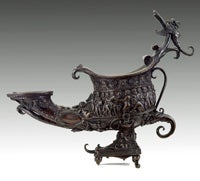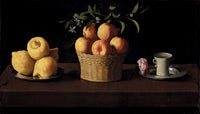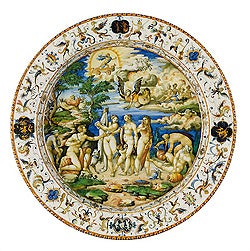Andrea Riccio: Renaissance Master of Bronze
October 15, 2008 through January 18, 2009
| |
 |
|
|
| |
Andrea Briosco Riccio (1470-1532), Lamp, 15th century, 16.83 cm high. The Frick Collection, New York, photo: Michael Bodycomb |
|
|
The Frick Collection presented the first monographic exhibition dedicated to Andrea Riccio (1470–1532), one of the most creative sculptors of the Renaissance. On view were thirty-one autograph works representing every phase of Riccio’s career, three bronzes believed to be derived from the artist’s lost compositions, and two life-size terracotta sculptures. Andrea Riccio: Renaissance Master of Bronze was shown exclusively at The Frick Collection.
Although celebrated during the sixteenth century as a “sovereign over bronze,” Riccio today is not widely known nor are his works generally understood. Representing both classical and religious subjects, they range from figurative statuettes to narrative reliefs to functional objects. His small-scale statuettes — such as the inimitable Shouting Horseman, from the Victoria and Albert Museum, London — embrace the themes of monumental Renaissance sculpture and painting while his narrative reliefs — including his tour de force Saint Martin and the Beggar from the Ca’ d’Oro, Venice — demonstrate his remarkable ability to re-envision Christian themes in his own original classical idiom. Functional bronzes — like the Frick’s superb Oil Lamp — evoke, in miniature scale, the artistry and symbolic complexity of Riccio’s great masterpiece, the Paschal Candelabrum, which remains in situ in the Basilica of Saint Anthony, Padua.
Riccio was born Andrea Briosco and gained his nickname because of his curly hair. He worked in Padua at a time when it was internationally renowned: the Basilica of Saint Anthony, or il Santo, was a locus of pilgrimage and its university was the greatest center of Aristotelian studies in Europe. The city attracted students and eminent scholars from across the continent, some of whom became Riccio’s patrons and friends. Riccio began his career there as a goldsmith but a chronic affliction forced him to specialize in bronze, a less strenuous art form. In this new field, he could model in soft materials such as wax or clay and exercise his talent as an inventor of compositions in relief and in the round.
Riccio was first employed by Bartolomeo Bellano, one of Donatello’s pupils. Both Bellano and Donatello created some of their greatest monuments in bronze for the Santo’s choir. Riccio’s training and experience thus located him within the illustrious tradition of bronze sculpture in Padua, where he would become its greatest sixteenth-century master.
Andrea Riccio: Renaissance Master of Bronze was organized by Denise Allen, Curator at The Frick Collection, and Peta Motture, Senior Curator of Sculpture at the Victoria and Albert Museum, London.
The exhibition was accompanied by a catalogue published by The Frick Collection in association with Philip Wilson Publishers, London. The catalogue was made possible by the generous support of the Robert Lehman Foundation, Inc. and the Thaw Charitable Trust.
Major funding has been provided by The Christian Humann Foundation, Mr. and Mrs. Howard Phipps Jr., and the Samuel H. Kress Foundation. Additional support has been generously provided by Mr. and Mrs. Walter A. Eberstadt, Mr. and Mrs. J. Tomilson Hill, Peter P. Marino, The Gladys Krieble Delmas Foundation, Hester Diamond, and The Peter Jay Sharp Foundation. The project is also supported, in part, by an award from the National Endowment for the Arts and by an indemnity from the Federal Council on the Arts and the Humanities.
Masterpieces of European Painting from the Norton Simon Museum
February 10 through May 10, 2009
| |
 |
|
|
| |
Francisco de Zurbarán, 1598-1664, Still Life with Lemons, Oranges and a Rose, 1633, oil on canvas, 62.2 x 109.5 cm, The Norton Simon Foundation |
|
|
The Frick Collection presented a selection of five masterpieces
of European painting from the highly acclaimed Norton Simon Museum in Pasadena, California. The exhibition, on view in the Oval Room from February 10 through May 10, 2009, afforded New York and East Coast audiences the occasion to see superb masterworks from the collections of the Norton Simon Art Foundation and The Norton Simon Foundation, a very special opportunity as both institutions generally do not allow their works to travel. The five featured paintings included Jacopo Bassano’s (Jacopo da Ponte, 1510–1592) Flight into Egypt, c. 1544–45; Peter Paul Rubens’ (1577–1640) Holy Women at the Sepulchre, c. 1611–14; Guercino’s (Giovanni Francesco Barbieri, 1591–1666) Aldrovandi Dog, c. 1625; Francisco de Zurbarán’s (1598–1664) Still Life with Lemons, Oranges and a Rose, 1633; and Bartolomé Esteban Murillo’s (1617–1682) Birth of Saint John the Baptist, c. 1655. None of these artists is represented in the Frick’s collection, and the outstanding quality of each of these Old Master paintings made them well suited to be viewed in the company of the Frick’s works.
The project was organized by Colin B. Bailey, Peter Jay Sharp Chief Curator of The Frick Collection, and Carol Togneri, Chief Curator of the Norton Simon Museum, with Margaret Iacono, Assistant Curator of the Frick. This exhibition marked the beginning of a series of reciprocal loan exchanges between the two institutions.
Masterpieces of European Painting from the Norton Simon Museum follows in the Frick tradition of presenting important Old Master paintings from American institutions that are less accessible to the New York public. Previous projects in this series have been: Masterpieces from The Cleveland Museum of Art (November 2006–January 2007); Masterworks from The Toledo Museum of Art (October 2002–January 5, 2003), and In Pursuit of Quality: 25 Years of Collecting Old Masters, Paintings from The Kimbell Art Museum, Fort Worth (November 1989–January 1990).
Norton Simon (1907–1993) was a pioneering entrepreneur whose enormous wealth derived from numerous business ventures ranging from the creation of a sheet metal distribution company and the triumphant revival of Hunt Foods, Inc. to the eventual formation of Norton Simon Inc., a multiindustry conglomerate that included Hunt-Wesson Foods, McCall’s Publishing, Max Factor cosmetics, and Avis Car Rental. Simon’s focus turned to art in the 1950s, and in the same intelligent and strategic manner employed to forge his business empire he amassed an art collection of great renown. Like museum collection of Henry Clay Frick, whom Simon admired enormously and whose museum was used as a model for his own, Simon’s evolved as his tastes did. His first acquisitions were Impressionist and Post-Impressionist works by such recognized masters as Degas, Renoir, Gauguin, and Cézanne. In the 1960s he began acquiring Old Masters and Modern works, choosing to sell many of his acclaimed French Impressionist paintings at the decade’s close; in the 1970s Simon’s appreciation for Indian and Southeast Asian art emerged and was reflected in his burgeoning collection. Today the Norton Simon collections consist of Western and Asian art spanning more than 2,000 years and contain paintings, sculpture, works on paper, and photography.
The exhibition is accompanied by a fully illustrated publication with an essay by Sara Campbell, Senior Curator, the Norton Simon Museum, as well as in-depth catalogue entries by Margaret Iacono, Assistant Curator, The Frick Collection. The softcover publication is available in the Museum Shop of the Frick, and by phone 212-288-0700.
Principal funding for Masterpieces of European Painting from the Norton Simon Museum is provided by Melvin R. Seiden in honor of Colin B. Bailey. Major corporate support is provided by Fiduciary Trust Company International. Additional support is generously provided by the Thaw Charitable Trust and Mr. and Mrs. John P. Birkelund. This exhibition is supported by an indemnity from the Federal Council on the Arts and the Humanities.
Portraits, Pastels, Prints: Whistler in The Frick Collection
June 2 through August 23, 2009
Between 1914 and 1919, Henry Clay Frick acquired twenty works by James
McNeill Whistler: five paintings, three pastels,
and twelve prints, a remarkable ensemble
that represents the breadth of Whistler’s
artistic activity and testifies to Frick’s taste as
a collector.
The museum’s four full-length portraits and single evocative seascape by Whistler are displayed in the Oval Room. During the exhibition, twelve etchings and three pastels from his Venetian sojourn of 1879–80 were brought together for the first time in more than twenty years and displayed in the museum’s Cabinet. Dating from 1866 to 1892, these works demonstrate the continuity of Whistler’s aesthetic concerns across three distinct media.

Watteau to Degas: French Drawings from the Frits Lugt Collection
October 6, 2009, through January 10, 2010
| |
 |
|
|
| |
Jean-Antoine Watteau (1684–1721), Woman Lying on a Sofa, c . 1717–18, red, black, and white chalk, 21.7 x 31.1 cm, Fondation Custodia, Paris |
|
|
Frederik Johannes Lugt (1884–1970) was a Dutch art historian, connoisseur, and collector. His fame in scholarly circles derives from two pioneering publications, still in use today: his Les marques de collections de dessins et d'estampes, published in 1921, which identifies the collectors' marks found on Old Master prints and drawings, and the Répertoire des catalogues de ventes publiques intéressant l'art ou la curiosité, a comprehensive listing of nearly 90,000 auction catalogues from sales occurring between 1600 and 1925, published in four volumes between 1938 and 1987.
Frits Lugt, as he was known, was a born collector. By the age of eight, he had sold his shell collection to the natural history department of Amsterdam's royal zoo; at fifteen, he acquired his first drawing. In his thirties, he began to collect in a more serious and systematic way, specializing in Dutch and Flemish drawings and prints, always his chief interest. During the 1920s, the decade in which he made his most important acquisitions, he also bought fifteenth-century Italian drawings and eighteenth-century French sheets.
Lugt was among the founders and principal supporters of the Rijksbureau voor Kunsthistorische Documentatie (RKD), the institute devoted to the study of Netherlandish art and artists, established in The Hague in 1930. In 1947, he created the Fondation Custodia in Paris, to care for and to add to his collection of 6,000 Old Master drawings and 30,000 prints.
The Frits Lugt Collection is widely regarded by specialists as one of the finest of its kind, but it is less well known to the general public. Curators at The Frick Collection were invited to select for the exhibition and its accompanying catalogue Lugt's finest eighteenth- and nineteenth-century French drawings, and the sixty-four works featured in the exhibition illuminate both Lugt's taste and that of his successors. Included are drawings and watercolors by well-known masters of the French School such as Watteau, Boucher, Fragonard, David, Ingres, and Degas, as well as by important figures who are less familiar to the general public. This is the first time that a group of French master drawings from the Fondation Custodia has traveled to New York.
Principal funding for the exhibition is provided by Peter and Sofia Blanchard; Elizabeth and Jean-Marie Eveillard; and Melvin R. Seiden in honor of Jean Bonna and Eugene V. Thaw.
Exuberant Grotesques: Renaissance Maiolica from the Fontana Workshop
September 15, 2009, through January 17, 2010
| |
 |
|
|
| |
Maiolica dish with The Judgment of Paris after Raphael, Fontana workshop, c. 1565, tin-glazed earthenware, The Frick
Collection, gift of Dianne Dwyer Modestini in memory of
Mario Modestini |
|
|
Although it was not until 2008 that the first piece of maiolica entered The Frick Collection, it was an extraordinary debut: a large dish painted with a narrative scene, or istoriato, inspired by Marcantonio Raimondi's print after The Judgment of Paris by Raphael. This scene is surrounded by colorful grotesques delicately painted on a white ground, a specialty of the renowned workshop of Orazio Fontana in Urbino, to which the best pieces are usually attributed.
This new acquisition — a gift to The Frick Collection by Dianne Dwyer Modestini in memory of her husband, Mario Modestini — is the inspiration for a small focus exhibition on the Fontana workshop's highly decorative maiolica painted with delicate grotesques on a whitened ground. The Frick Collection's piece will be shown along with five related works on loan from The Metropolitan Museum of Art and the Philadelphia Museum of Art.
The exhibition illustrates the technical and artistic excellence reached in the Fontana workshop in the third quarter of the sixteenth century. This presentation of pieces of different shapes will provide an opportunity for visitors to view the richness of table services made in maiolica for the Renaissance aristocracy.
The exhibition organized by Andrew W. Mellon Curatorial Fellow Charlotte Vignon is accompanied by a scholarly catalogue, including detailed entries and an essay on the history of collecting Renaissance maiolica.
The exhibition is made possible by The Andrew W. Mellon Foundation and The Gladys Krieble Delmas Foundation.
The accompanying catalogue has been generously underwritten by the Robert H. Smith Family Foundation. |


